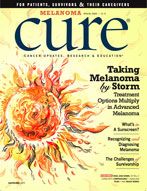Publication
Article
CURE
The Evolution of Melanoma Treatments
Author(s):
Melanoma has been a primary focus in immunotherapy research because of intriguing evidence that some people's immune systems are better able to keep the cancer in check.
Melanoma is skin cancer that forms from melanocytes, the cells in the skin that contain pigment. Basal cell and squamous cell carcinoma are easily treated and far more common forms of skin cancer. Far rarer, melanoma still accounts for the majority of deaths from skin cancer. Caught early enough, surgery can cure it. But once the disease escapes and becomes metastatic, it ranks among the most aggressive and difficult of cancers.
Dacarbazine has been the approved chemotherapy for metastatic melanoma since 1975, but with minimal success. Chemotherapy focuses on directly killing cancer cells, but the new types of melanoma drugs are more clever: Immunotherapy harnesses the body’s own immune system to fight cancer. Targeted therapy interferes with other cellular growth pathways within the cancer that can slow or shut it down.
Melanoma has been a primary focus in immunotherapy research because of intriguing evidence that some people’s immune systems are better able to keep the cancer in check. In one remarkable case, a patient contracted melanoma from a kidney transplant; the donor had been presumed surgically cured 16 years before the organ donation. Melanoma is also the most mutated of cancers, so is more likely to trigger a response by the immune system, according to Roda Amaria, a melanoma specialist at MD Anderson Cancer Center in Houston.
Interleukin 2 (IL-2), approved in 1998 and still used, was an early effort in immunotherapy. A naturally occurring molecule in the body, it helps activate the immune system to recognize and destroy cancer cells, shrinking tumors in about 15 percent of patients. A lucky 5 percent enjoy a remission that can last beyond seven years. The side effects are extreme, ranging from nausea and vomiting to dangerously low blood pressure caused by leaking blood vessels. A similar drug is interferon alfa.
Newer treatments for melanoma have been developed over a long period of time, with the process beginning back in the early 2000s. Some patients, like Peter Daly, remember those early days well.
In 2002 — on his 49th birthday — he’d been diagnosed with metastatic melanoma. After evaluating the dismal track record of the few available treatments, he decided he’d rather take his chances with a clinical trial. He enrolled in an anti-cancer vaccine study, but just six months later his cancer returned.
His doctors in Madison, Wisconsin, treated him with interferon alfa-2b in an effort to keep the cancer at bay, but it returned again, literally from head to foot. Finally another trial opened, this time for the immunotherapy Yervoy (ipilimumab), at the National Cancer Institute in Bethesda, Maryland. A phase 1/2 trial, its primary goal was figuring out if the human body could tolerate the drug, and how much of it. So little was known that the consent documents Daly signed contained information on how it had worked in monkeys. He knew the trial could kill him, but he also knew if he did nothing the melanoma would kill him. Unfortunately, Daly’s body did not handle Yervoy well. After just two doses he developed colitis. He was willing to risk a third dose, but the doctors declined.
But two doses had been enough. Within weeks, Daly felt the tumors shrinking. A couple of large growths had to be removed or irradiated, but, spurred by the Yervoy, his own immune system gradually beat back the myriad tumors. Within a few years he was declared to have no evidence of disease — an early success story to buoy researchers.
It would take another seven years of clinical trials, but in 2011 Yervoy was finally approved by the FDA. It was the first new drug for the treatment of metastatic melanoma in 13 years. And it was the first melanoma drug ever to show overall survival benefit in a randomized phase 3 clinical trial.
Yervoy was just the beginning. Seven additional drugs have been approved since.
“For years we really didn’t have any effective therapy,” says Lynn Schuchter, chief of hematology/oncology at the Abramson Cancer Center at the University of Pennsylvania, who has been a melanoma specialist for more than 25 years. “It’s been quite remarkable to suddenly have tears of joy in clinic and not just tears.”





